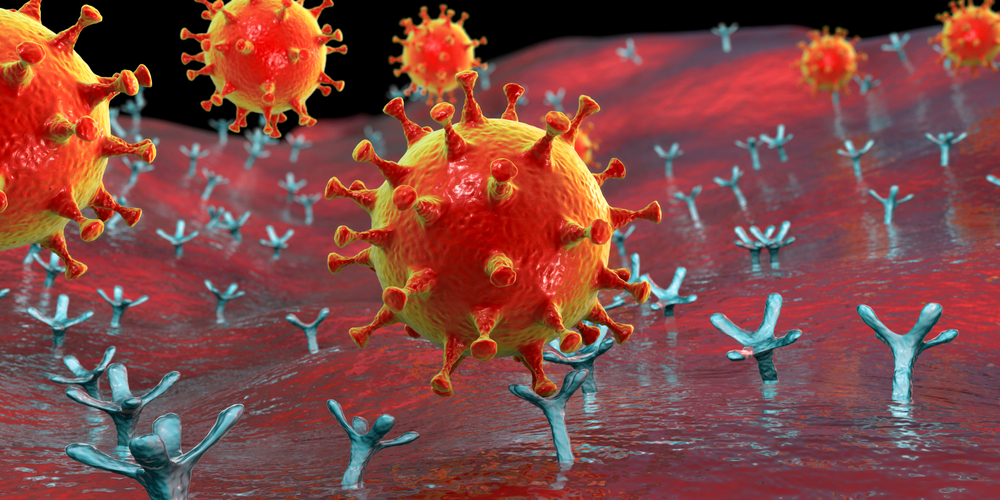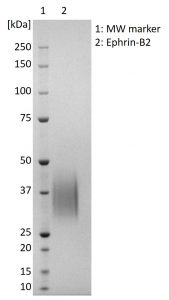SDS-PAGE showing 1µg purified Ephrin-B2 (EFNB2) protein. The molecular mass is approximately 35-40 kDa due to glycosylation.
Human Ephrin-B2 (EFNB2), His-Tag
Price range: $596.98 through $3,783.68 excl. VAT
Recombinant EFNB2 protein produced in HEK293 cells and purified from culture supernatant. Protein contains an C-terminal 6x His-tag.
HUMAN EPHRIN-B2 (EFNB2), HIS-TAG
Recombinant EFNB2 protein produced in HEK293 cells and purified from culture supernatant. Protein contains an C-terminal 6x His-tag.
PRODUCT DETAILS – HUMAN EPHRIN-B2 (EFNB2), HIS-TAG
- Recombinant EFNB2 protein produced from HEK293 cells (NCBI Accession Number: NP_004084.1).
- Includes amino acids 1-226 and a C-terminal His-tag.
- Greater than 95% purity by SDS-PAGE and buffered in DPBS, pH7.4.
BACKGROUND
Human Ephrin-B2 is encoded by the EFNB2 gene, a EFNB class ephrin which binds to the EPHB4 and EPHA3 receptors (Bonaldo, et al., 1994). EFNB2 is a member of the family of transmembrane-anchored ligands of the ephrin receptor tyrosine kinase family, the largest subgroup of receptor tyrosine kinases known (Poliakov, et al., 2004; Pasquale, 2004) and are type I membrane glycoproteins.
Ephrin receptors and their ligands are known to participate in cell-cell interactions, including those of vascular endothelial cells, and are modulators of cell migration in remodeling events, especially in the nervous system. EFNB2 expression is seen in most human tissues to varying degrees.
Hendra virus (HeV) and Nipah virus (NiV) belong to the genus Henipavirus of the family Paramyxoviridae and are unique in that they exhibit a broad species tropism and cause fatal disease in both animals and humans. They infect cells through the same pH-independent membrane fusion process mediated by their fusion and attachment glycoproteins.
EFNB2 has been shown to serve as a functional receptor for both Hendra virus (HeV) and Nipah virus (NiV). Non-permissive cells transfected with a vector encoding EFNB2 became permissive for HeV- and NiV-mediated cell fusion as well as infection by live virus. Additionally, recombinant EFNB2 could potently block fusion and infection and bind recombinant HeV and NiV attachment glycoproteins with high affinity (Bonaparte, et al., 2005).
REFERENCES
- Bonaldo, M. F. et al., 1994. Selection of cDNAs using chromosome-specific genomic clones: application to human chromosome 13. Human Molecular Genetics, 3(9), p. 1663–73.
- Bonaparte, M. I. et al., 2005. Ephrin-B2 ligand is a functional receptor for Hendra virus and Nipah virus. Proc Natl Acad Sci U S A., 102(30), pp. 10652-7.
- Pasquale, E. B., 2004. Eph-ephrin promiscuity is now crystal clear. Nat Neurosci., 7(5), pp. 417-8.
- Poliakov, a., Cotrina, M. & Wilkinson, D. G., 2004. Diverse roles of eph receptors and ephrins in the regulation of cell migration and tissue assembly. Dev Cell, 7(4), pp. 465-80.


